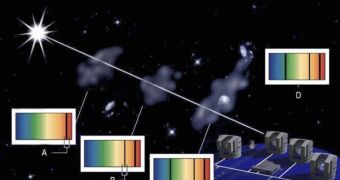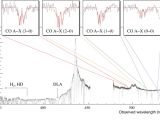With the help of the Very Large Telescope, ESO astronomers have recently obtained an ultraviolet signature of carbon monoxide molecules inside a well hidden galaxy located 11 billion light years away from Earth. The VLT used its UVES spectrograph for a period of 8 hours to study the galaxy, during which time it obtained an accurate measurement of the cosmic temperature of that remote era. This was done by analyzing the spectral imprint left by the interstellar gas of the galaxy on the light given away by background quasars.
"Quasars are here only used as a beacon in the very distant Universe. Interstellar clouds of gas in galaxies, located between the quasars and us on the same line of sight, absorb parts of the light emitted by the quasars. The resulting spectrum consequently presents dark 'valleys' that can be attributed to well-known elements and possibly molecules", said Raghunathan Srianand, leader of the study, in a press release posted on ESO's website.
The quasar used in the experiment was chosen from a group of ten thousand others and revealed the presence of deuterated molecular hydrogen and carbon dioxide in the interstellar space of the remote galaxy. "This is the first time that three molecules have been detected in absorption in front of a quasar, a detection that has remained elusive for more than a quarter century", says Cedric Ledoux of the ESO.
Galaxies form by turning intergalactic and interstellar gas into stars and other cosmic bodies and the formation and the state of molecules are largely dependent on the rate at which stars form, thus providing researchers with an invaluable tool to understanding exactly how galaxies are formed. According to their study, the physical conditions in distant galaxies and the Milky Way are relatively similar.
The new study has also conducted the most precise measurement of the temperature of the cosmic background radiation in the distant universe. "Unlike other methods, measuring the temperature of the cosmic background using CO molecules involves very few assumptions", said co-author of the study Pasquier Noterdaeme.
The cosmic background is a signature left behind by the Big Bang, the event that created the universe, which may stand as evidence that the universe was much warmer in a distant past. "Given the current measured temperature of 2.725 K, one would expect that the temperature 11 billion years ago was about 9.3 K. Our unique set of VLT observations allows us to deduce a temperature of 9.15 K, plus or minus 0.7 K, in excellent agreement with the theory", said Patrick Petitjean of the ESO.
"We believe our analysis pioneer interstellar chemistry studies at high redshift and demonstrates that it is possible, together with the detection of other molecules such as HD or CH, to use interstellar chemistry to tackle important cosmological issues", Srianand said.

 14 DAY TRIAL //
14 DAY TRIAL // 
